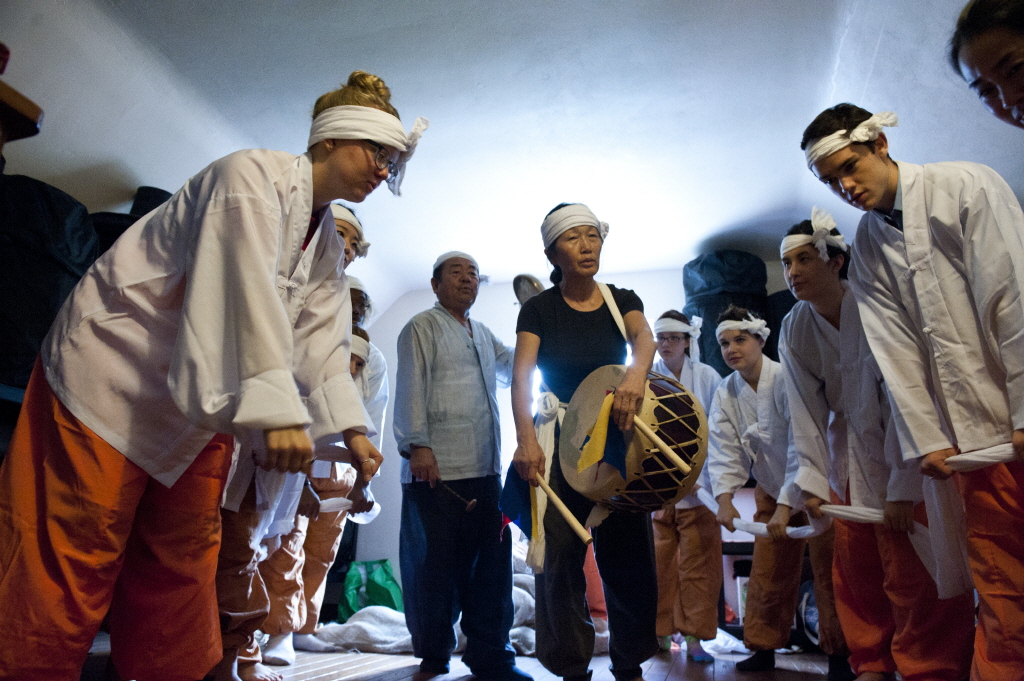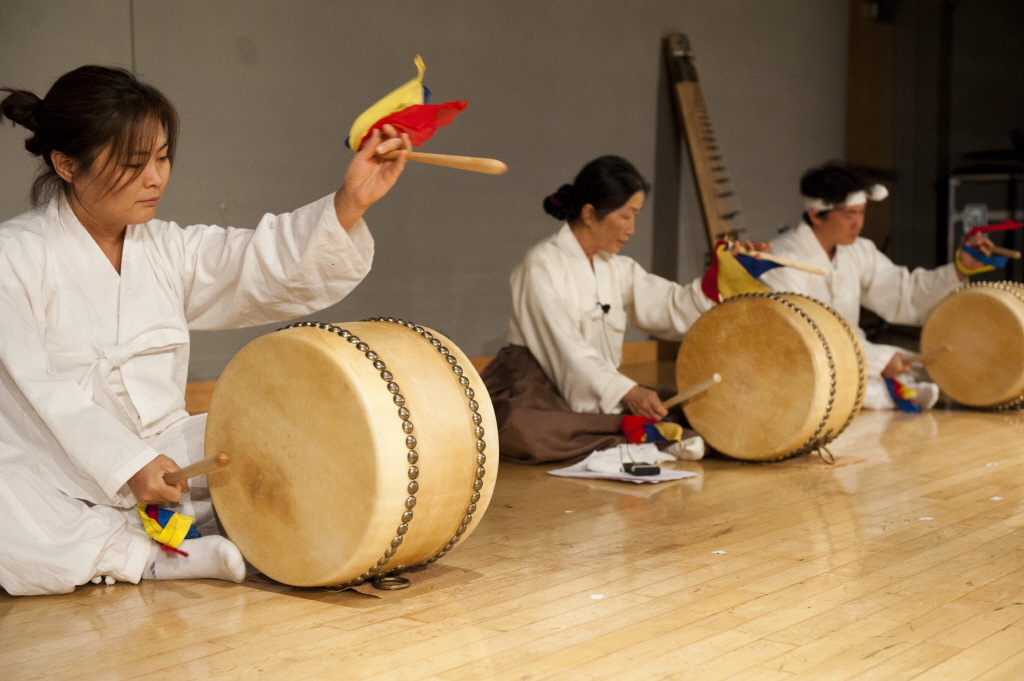Jindo Island Folk Performance a huge success
By Mika Sasaki (fourth year student in Korean program
On October 9th, I had the great opportunity to participate in a traditional Jindo performance workshop. The workshop was led by Mr. Cho Ohwhan, Ms. Go Mikyoung, and Professor Chan E. Park. The workshop opened with a lesson on how to sing and dance to “Ganggangsullae,” in the style that people from Jindo Island would perform. “Ganggangsullae” is a dance that is presented on certain Korean holidays in order to produce a plentiful harvest. After coordinating the right dance movements to the words of the song, the participants of the workshop linked hands and weaved around the room, performing “Ganggangullae.” This was then followed by a performance of a traditional burial ceremony. Mr. Cho Ohwhan, Ms. Go Mikyoung, and Professor Chan E. Park worked together to show an amazing drum performance. With the few minutes remaining, the professors taught participants how to sing the first few verses of “Arirang,” in Jindo style.
The next day, on October 10th, a beautiful evening program entitled “Songs of Living and Dying: An Evening of Korean Music,” highlighting Jindo performance, was held at the Ohio Union. The night started with a drum performance by Mr. Cho, Ms. Go, Professor Park, and a couple of other performers. This was followed by a beautiful solo dance by Ms. Go. The night proceeded with a presentation by Professor Park, performing a wonderful piece on the Korean zither, called the geomungo. Later Mr. Cho sang with Ms. Go in a lively “taffy dance.” In Korea, taffy vendors would traditionally make long strips of taffy, yeot, and would carry scissors to cut it into edible sizes. This Korean tradition is celebrated through the “taffy dance”, a cheerful, upbeat dance, accompanied with the rhythmic clanking of the metal scissors used to cut yeot. Perhaps my favorite part of the night was the burial ceremony performance where students, dressed in white, performed a traditional ceremony for the dead. Following was a jaw-dropping drum performance by Mr. Cho, Ms. Go, and Professor Park. The night ended with the audience joining hands with the performers to sing “Ganggangsullae”.
For me, my favorite part of both the Jindo performance workshop and the Jindo performance evening program was the presentation of the burial ceremony. In place of the deceased, the pallbearers would give a final goodbye greeting to the people gathered. What I found interesting about the burial ceremony was that it began with a slow, sad song, but later progressed into an upbeat performance with drums. I had the honor of speaking with Mr. Cho after the workshop and he noted that Koreans would dance and sing at the end of the burial ceremony in order to send off the dead person happily. It was a way of wishing the dead a happy journey and afterlife in the heavens. In America, we usually do not have such customs. Seeing this ceremony helped me gather even more respect for Korean culture. I came to realize that actually if one makes burial ceremonies overly depressing, the deceased and the family of the deceased can become even sadder and it makes it harder to send off their beloved. I really enjoyed the workshop and performance. I think it captured the spirit of Korean culture in a very beautiful way.
Korean Version
사사키 미카
10월 9일에 오하이오 유니언에서 했던 진도 전통 공연 연구 집회에 참석했어요. 연구 집회에서 초 선생님, 고 선생님, 그리고 박 교수님께서 강강술래 춤과 노래를 어떻게 하는지 가르쳐 주셨어요. 강강술래를 배운 후에 다른 학생들이랑 다 같이 연습도 했어요. 손을 잡고 한 줄을 만들어서 방 주위를 돌았어요. 그리고 매장식을 봤어요. 마지막에는 고 선생님과 박 교수님께서 훌륭한 북 공연을 보여 주셨어요. 남은 몇 분 동안은 아리랑 노래도 가르쳐 주셨어요.
그 중에서 제가 제일 좋았던 부분은 매장식이었어요. 죽은 사람을 대신해서 운구 행렬들이 동네 사람들에게 마지막 인사를 해요. 매장식을 할 때 처음에는 노래가 조금 슬픈데 점점 더 노래가 낙관적으로 변해요. 저는 이것이 너무 좋았어요. 북을 치고 춤을 추면서 죽은 사람을 즐겁게 보낼 수 있어서요. 미국의 매장식은 그렇게 하지 않는데 너무 우울하게 하면 죽은 사람과 죽은 사람의 가족들이 다 더 슬퍼지고 죽은 사람을 보내기가 더 힘들어져요. 저는 이번 연구 집회가 아주 재미있었어요.


